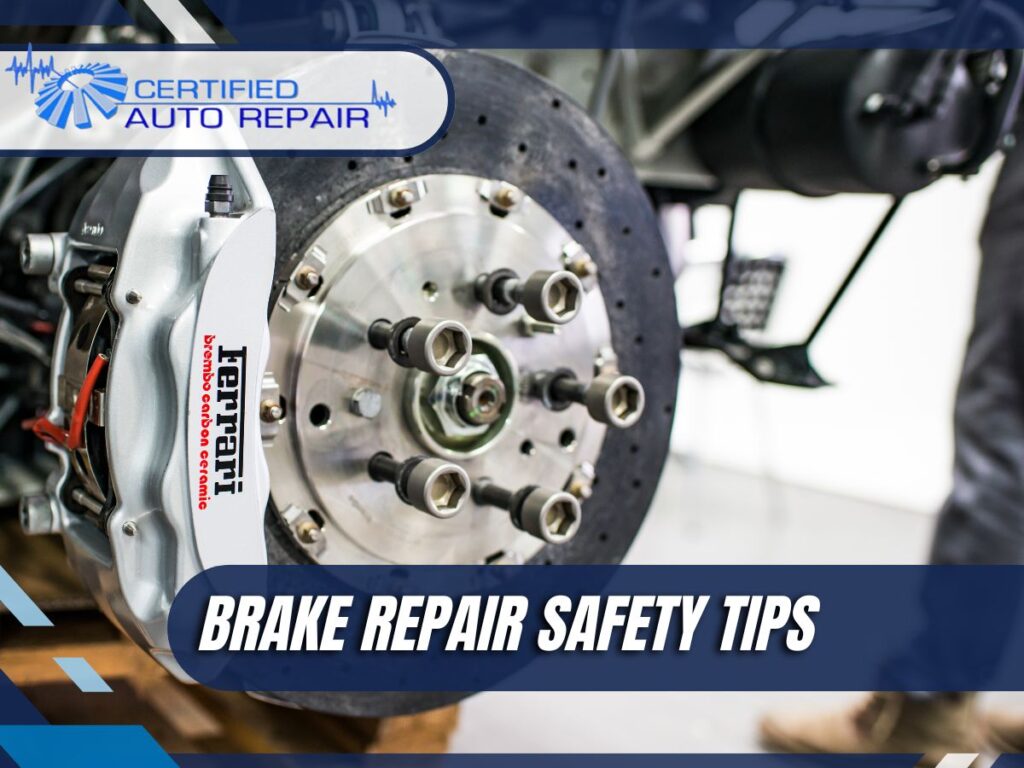Why Brake Repair Safety is Critical
Your braking system is one of the most vital components of your vehicle, directly affecting your safety on the road. When brakes fail, accidents happen. Whether you’re performing routine maintenance, replacing brake pads, or fixing a leak, brake repair requires careful handling, the right tools, and proper safety precautions.
Ignoring safety measures can lead to injuries, incorrect repairs, or compromised braking performance. Understanding common risks, essential safety steps, and expert repair techniques will help ensure your brake repair is done correctly and safely.
This guide will walk you through the best safety practices for brake repair, covering protective gear, proper lifting techniques, common mistakes to avoid, and real-world examples to help you work safely and effectively.

1. Wear the Right Protective Gear
Why Protective Gear Matters
Brake repairs expose you to dust, chemicals, and moving parts. The right safety gear helps protect against injuries, toxic exposure, and accidental burns.
Essential Safety Gear for Brake Repair
- Gloves: Prevent direct contact with brake fluid and grease.
- Safety Glasses: Protect your eyes from debris, dust, and brake fluid splashes.
- Dust Mask or Respirator: Brake dust can contain harmful particles—avoid inhaling it.
- Steel-Toe Shoes: Protect your feet from falling tools or heavy components.
Real-World Example:
A DIY mechanic attempted a brake pad replacement without gloves or safety glasses. When loosening the caliper bolts, brake fluid sprayed into his eyes, causing irritation and temporary blurred vision. This could have been prevented with proper eye protection.
2. Work on a Level Surface and Use Jack Stands
Why Vehicle Stability is Crucial
Lifting your vehicle improperly can lead to falls, injuries, or damage. Always ensure your car is securely positioned before working on brakes.
Safe Lifting Steps
- Park on a level surface and engage the parking brake.
- Use wheel chocks to prevent rolling.
- Lift the vehicle with a jack and place jack stands under the frame for additional support.
- Never work under a car supported only by a jack—always use jack stands.
Case Study: The Dangers of Skipping Jack Stands
A technician once attempted a brake rotor replacement without using jack stands. The jack slipped, causing the car to fall suddenly. Fortunately, no one was underneath, but it could have been a fatal mistake.
3. Handle Brake Fluid with Caution
Why Brake Fluid Can Be Dangerous
Brake fluid is highly corrosive and can cause skin irritation, eye damage, and paint damage if spilled.
Safe Handling Tips
- Wear gloves to avoid skin contact.
- Avoid spills on painted surfaces—brake fluid can strip paint.
- Dispose of old brake fluid properly—never pour it down a drain.
What to Do in Case of a Spill
- On skin? Wash immediately with soap and water.
- In eyes? Rinse with clean water for 15 minutes and seek medical attention.
- On paint? Wipe off immediately and clean with water.
4. Be Aware of Brake Dust Hazards
Why Brake Dust is Harmful
Brake dust contains fine metal particles and asbestos fibers (in older vehicles), which can cause lung damage if inhaled.
Safe Ways to Handle Brake Dust
- Never use compressed air to clean brake dust—it sends harmful particles into the air.
- Use a brake cleaner spray to safely remove dust.
- Wear a dust mask or respirator while working on brakes.
5. Double-Check Your Work Before Driving
The Importance of a Post-Repair Inspection
Even small mistakes in brake repairs can lead to major safety issues on the road.
Steps to Verify Your Brake Repair
- Check for leaks: Inspect the brake lines and master cylinder for fluid leaks.
- Ensure bolts and calipers are secure: Loose components can cause braking failures.
- Test the brakes before driving: Pump the brake pedal to restore pressure.
- Perform a low-speed test drive: Brake gently to ensure proper function before driving normally.
Case Study: Loose Caliper Bolts Causing Brake Failure
A customer came in with severe brake noise and vibration after a DIY pad replacement. The issue? The caliper bolts were left loose, causing the caliper to shift dangerously while driving. A simple post-repair check could have prevented this issue.
6. Know When to Seek Professional Help
When DIY Repair May Not Be Safe
While brake pad replacements and fluid changes are manageable for some DIYers, complex repairs require specialized tools and expertise.
Signs You Should Consult a Professional
- Brake lines are leaking or severely rusted.
- The master cylinder is failing.
- You experience unresponsive or inconsistent braking.
Brake safety is non-negotiable. If you’re unsure about any repair, consult a certified technician.
Prioritizing Safety in Every Brake Repair
Brake repairs demand precision and caution. Whether you’re replacing pads, fixing leaks, or bleeding the system, following proper safety procedures prevents injuries and ensures brake reliability. From wearing the right gear and securing the vehicle to handling brake fluid properly and double-checking your work, every step matters.
FAQs About Brake Repair Safety
1. What is the most common mistake people make during brake repairs?
Failing to properly secure the vehicle with jack stands or forgetting to bleed air from the brake lines after a fluid change.
2. How do I safely remove brake dust?
Use a brake cleaner spray and avoid blowing dust into the air with compressed air.
3. Can I mix different types of brake fluid?
No. Always use the brake fluid type specified in your owner’s manual to prevent brake failure.
4. What should I do if my brake fluid gets on my skin or eyes?
Immediately rinse with water and seek medical attention if irritation persists.
5. How often should I check my brakes?
Brake inspections should be done every 12,000 miles or at least once a year.
